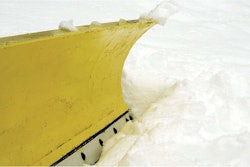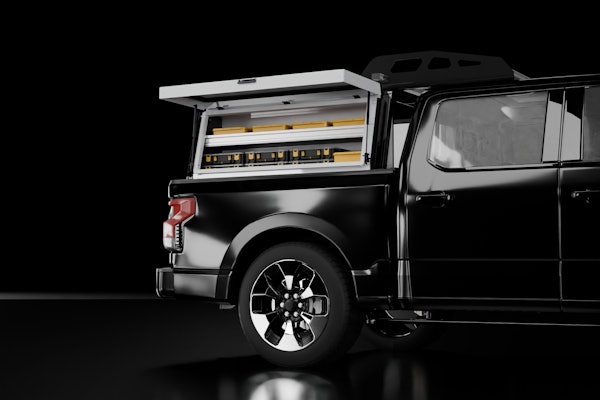Innovation Rolls On
4 trucks that meet the needs of professionals with refinements and fresh thinking
Pickups and low-cab forward/cab-over engine trucks are the workhorses of the landscaping industry. You want reliability, sensible costs, capabilities to do various jobs and efficiency. After test-driving a fleet of new offerings, here are four dubbed among the most noteworthy for landscape contractors by our colleagues at ProPickup and CCJ (Commercial Carrier Journal) magazines.
Game Changer
By Bruce W. Smith
Fuel-friendly 2011 Ford F-150 EcoBoost V-6 delivers towing capacity and pulling power of a big-block.
Usually a 6,800-pound box trailer puts a crimp on a half-ton pickup’s ability to keep pace with hill-country traffic. But that’s not the case with the 2011 F-150.
The F-150’s new V-6 option packs surprising power.
What I realized after the first 10 minutes of driving the new F-150 on the interstates and hill-country roads near Dallas is if you are running with competitors’ half-tons or any older model F-150, rest assured, all they’ll see is your tailgate – trailer in tow or not.
The kicker is the engine in the Crew Cab 4×4. I wasn’t driving Ford’s new 411-horsepower 6.2L big-block V-8, but rather the equally new 3.5L EcoBoost V-6.
While the big-block depends on cubic inches to deliver power, Ford’s 356-horsepower EcoBoost V-6 depends on two baby turbos to deliver its muscle; 90 percent of that muscle is available between 1,500 to 5,000 rpm.
The six-speed automatic found in all of the 2011 F-150s complements the EcoBoost’s wide power band. It’s nice to have a six-speed in a pickup, and Ford’s truck has a tow/haul mode. The driver can select which gear it tops out, so when towing trailers, it’ll stay in the rpm-range of your choosing. The shifts are swift and well-spaced.
The EcoBoost also differs from the big-block where it counts even more for contractors with multiple pickups: lower purchase price and annual operating cost.
The new 3.7L V-6 is the base engine for the 2011 F-150. The 5.0L option adds $1,000, the twin-turbo 3.5L EcoBoost option $1,750 and the 6.2L big-block is a $2,995 upgrade.
Ford says all of their new engines – the 3.7L V-6, 3.5L twin-turbo V-6, 5.0L and 6.2L V-8s – are 20 percent more economical than the engines in the 2010 F-150s. If that’s true, the EPA numbers should put a 3.5L-powered four-wheel-drive F-150 in the 21-22 mpg range, with city numbers between 16-17 mpg.
Choosing the EcoBoost V-6 that has the same tow capacity and performance of a big-block, but without the associated operating costs, is an option we think many landscape contractors will gravitate toward when it comes to lease/purchase time.
King of the Hill
by Jack Roberts
Comfort and class come with the ride of Ford’s 2011 F-250 Super Duty
Whether you’re the owner of a small landscaping enterprise or the CEO of a mega-sized contracting corporation who loves the Blue Oval, there is no Super Duty more packed with luxury features than the King Ranch trim-level package.
Its styling is meant to appeal to people who want their rolling office/company calling card to reflect the finer things in life, as evidenced by the plush leather appointments, wood-grain trimmed dash and special edition wheels.
The Super Duty Crew Cab 4×4 sported comforts from heated/cooled seats power seats, sun/moon roof and power-sliding rear window to a full audio-visual entertainment/navigation system and intuitive and simple to operate driver information system.
Ford’s optional Work Solutions integrated software business programs turns the onboard computer system into a direct link to your office – or make the truck your office.
The new diesel PowerStroke is amazingly quiet and kicks out plenty of low-end torque, two aspects landscape contractors will love as much as the interior appointments. The power delivery is instantaneous, too; there’s no turbo lag as it accelerates with the swagger of a big-block gas engine.
Fuel economy for this truck isn’t bad, either, considering both the size of the engine and the mass it has to move down the highway.
Ford’s driver information center features real-time fuel economy data with a configurable window, graphing MPG performance over the past five minutes (or longer periods if you like) while displaying instant and average econ numbers.
I found that my fuel mileage in city traffic varied between 13-17 mpg with a week-long average of 15.1 mpg. On the highway, that figure nipped 19 mpg when speeds stayed below 60mph and averaged 17.3 mpg during our 100-mile interstate test loop running 70 mph. Those are fuel numbers any contractor or landscaper can live with.
“Demand for this truck is so strong that we were determined to resume production as soon as possible.”
On those tough job sites, the four-wheel-drive engagement system is quick and easy to use – and will snap your head back if you are too aggressive with the throttle in 4-Lo. The electronic-locking differential ($390) is a must-have option for maximum off-pavement traction.
Out on the open road there’s no wander in the steering. Interior sound levels are more akin to that of a nice car than a heavy-duty pickup, so long drives and business can be conducted with ease. And despite its bulk, the F-250 proved to be surprisingly nimble in parking lots and city traffic.
Notable Improvements and Performance
By Jeff Crissey
The Mitsubishi Fuso Canter FE/FG series delivers.
The often-used phrase, “new and improved,” seems a contradiction – if something is new, how can it be improved? But in the case of the 2012 Mitsubishi Fuso Canter, the phrase makes sense. While the new Canter shares the same nameplate as the 2010 model, much of the truck itself is completely new.
The Canter sports a more aero look.
New features include the drivetrain, selective catalytic reduction (SCR) emissions technology, a bold, athletic exterior and completely redesigned interior.
The 2012 Canter line is comprised of five cab-over models from Class 3 through 5: the FE125, FE160 and FE 180, as well as a seven-passenger crew cab model (FE160CC) and four-wheel-drive truck (FG4X4).
At the top of the list of new features is the Canter’s Duonic 6-speed automatic-manual transmission. The dual-clutch transmission is unique in the commercial truck market.
Gear shifts are smooth and seamless, similar to a passenger car. The Duonic system uses electronically controlled hydraulic solenoids to cycle through transmission gears. A driver-selectable ECO mode predicts shift changes in advance and shifts the engine at the optimal time to improve fuel economy and performance.
The Canter FE 110.2-inch wheelbase provides a 34.1-foot turning diameter, making it easy to maneuver in and around congested urban areas.
The truck is powered by the three-liter 4P10 dual-overhead-cam, in-line four-cylinder diesel engine with common rail fuel injection.
While the cab structure and doors are largely unchanged from 2010, the front end has been updated with a stylish, robust appearance. The grill’s brow slants to the middle for improved aerodynamic performance, and the vertical lines extend through the front bumper for a cohesive, integrated look.
Mitsubishi Fuso completely redesigned the cab’s interior, allowing more space and maneuverability. A dash-mounted shifter allows complete access between the driver and passenger area, allowing the driver to easily exit the cab from the passenger side when necessary. The center and passenger seats fold down to provide the driver with a workspace
The dash console features a new display that allows the driver to cycle through a number of screens, including a diesel particulate filter level gauge, average fuel economy and speed, fluid levels and performance parameters.
The Vortec Is Back
by Jack Roberts
Isuszu’s NPR, a gas-powered favorite, returns and performs with impressive results.
The return of the Isuzu NPR gas-powered, low-cab forward truck is welcome news for landscapers who need an economical option and don’t wish to pay the added acquisition and operating costs associated with diesel engines.
Isuzu NPR
“This is the only gasoline-powered, low-cab forward truck available,” says Shaun Skinner, executive vice president and general manager of Isuzu’s North American operations. “It is the perfect powertrain tool for challenging applications or body configurations where a diesel engine won’t work.”
Isuzu and General Motors have a long history of collaboration. And the highly successful NPR truck was a prime example of this cooperation. But when GM hit financial hard times in 2008, it closed the assembly plant where NRP trucks were mated with 6.0 liter Vortec gas engines.
“But demand for this truck is so strong that we were determined to resume production as soon as possible – and that plan has worked out perfectly,” Skinner says.
Mating GM’s premier V-8 truck engine with this lightweight and nimble truck was enlightened technological matchmaking.
NPRs with gross vehicle weight ratings of 12,000 and 14,000 pounds can be spec’d with the Vortec engine, which churns out an impressive 297 horsepower and 372 foot-pounds of torque.
The engine is so powerful and peppy, care has to be taken when driving an unloaded truck not to burn a tire or give your passengers whiplash.
The NPR provides ample and instantaneous horsepower for fast starts and easy highway merges with plenty of low-end torque to get a full load quickly up and going.
Climbing into an NPR cab is always a delight: The commanding front and side visibility that Isuzu is known for makes a big first impression. There’s no long-nosed hood to look over, and the added measure of safety this extra visibility gives drivers is undeniable, especially in urban areas.







